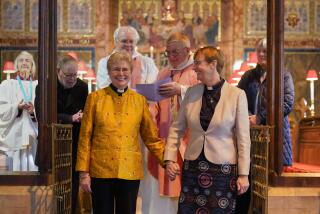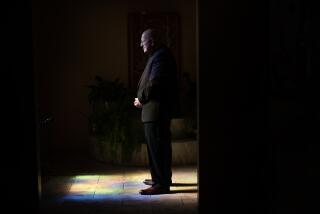Communal ‘Time for Reckoning’ Gaining Acceptance in County
- Share via
Father Timothy Doyle’s pre-Easter homily on the subject of sin, pride and forgiveness included quotations from the short story writer Flannery O’Connor and the poet Emily Dickinson, an Irish saying and a favorite personal anecdote.
Then, looking out over the 450 worshipers who filled the pews of Holy Spirit Catholic Church in Fountain Valley for a Penance Service, he said the simple words his parishioners had come to hear: “Now is the time for reckoning.”
The priest called on the congregation to join in an observance in which the traditional individual Roman Catholic confession is performed as an act of communal reconciliation.
Church officials and congregants, including those invited to the service from neighboring St. Barbara’s parish in Santa Ana, said that the Vatican II reform of the Rite of Penance is becoming increasingly popular in Orange County. Under the reform instituted by the Vatican II council in the early and mid-1960s, individual parishioners may choose to confess their sins to a priest in a communal setting, in addition to retaining the option of the traditional private confession.
Long Lines
After introducing the nine other priests who had come to make the observance possible, Doyle announced where they would be stationed in the sanctuary and in an adjoining hall at the rear. Two of the priests moved into the traditional divided wooden booths, where the individual makes a confession through a screen to the priest seated on the other side. The remainder took chairs in the open--one was stationed on each side of the pulpit and others were placed throughout the hall.
As a choir, accompanied by three guitars and a tambourine, sang hymns, worshipers rose from their seats and formed long lines in the aisles to await a moment with a priest. Those waiting stood at distance, out of earshot, but the conversation between each priest and penitent was entirely visible. Some of the penitents would look into their confessor’s eyes; others avoided eye contact. Some took the hand of the priest as they spoke or embraced when they finished.
Visible among the hundreds of confessions observed over a period of several hours, even under the bright lights, were many intimate, moving moments. Small gestures of the priests--a head inclined, a graceful hand motion, a touch, a clasp--provoked expressions of obvious comfort and relief on the penitents’ faces. The line to the six priests in the adjoining hall operated on a feeder basis, “like a bank line,” said one of those standing in it, or like that at an automated teller, where the next customer remains at a respectful distance while the secret code is punched in.
Making confession, said Mike White of Fountain Valley, is “much harder to do face-to-face,” although “it’s much more rewarding out in the open.”
“You ask forgiveness of the community,” said his wife, Mary, “as opposed to being in the enclosure.”
‘More Meaningful’
“More of a community spirit prevails,” said Joe Mata of Westminster, who attended the service with his wife and children. “You still have the one-to-one relationship,” he said, “but it’s much more meaningful.” Inside the confessional, he said, “you lose the personal relationship.”
“We never saw the priest smile,” said Mary Mata, his wife, of the days before the new rite. As a nurse, Mata said, she values the importance of touch. “It’s comforting,” she said, to hold the hand of the priest while speaking. “What you get is the idea that they (the priests) are human too.”
“We’ve had a tremendous response to Penance Services,” said Father Art Holquin, director of liturgy and music for the Diocese of Orange. The services, Holquin said, are usually held twice a year, just before Christmas and Easter, because “it’s especially appropriate during Holy Week,” and as a result parishioners “see it as a very graced time for them.”
Under Vatican II, Holquin said, the option for anonymous confession must be offered whenever the communal celebration, which is “becoming more popular in the United States,” is offered. In Orange County, this kind of service has been conducted since the late 1970s, he said, noting that, as a priest, he has seen the practice become more and more accepted.
Differences Noted
“I have found in the past seven years people have become far more comfortable seeking out face-to-face confessions,” he said. There is a difference, he said, in the way confession is made out in the open, “a greater tendency for people to have a more conversational style rather than a formal recitation. It’s a bit awkward to carry on a dialogue through a screen, a bit stilted.”
Whether to make eye contact with the penitent “depends on the personality of the priest,” Holquin said. “It’s something you just sort of sense.”
Hearing confession through a screen, he said, became common in the 14th and 15th centuries, growing out of “a great concern on the part of the church to protect the security and anonymity of confession,” the confidentiality of which remains inviolable.
The rationale behind the communal confession, he said, is that “sin affects the community of believers,” and that by confessing in this manner people acknowledge “the communal dimension of our sinfulness.”
More to Read
Sign up for Essential California
The most important California stories and recommendations in your inbox every morning.
You may occasionally receive promotional content from the Los Angeles Times.









